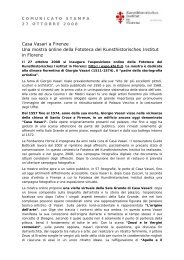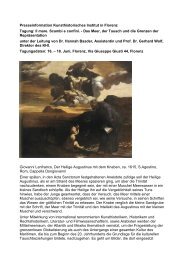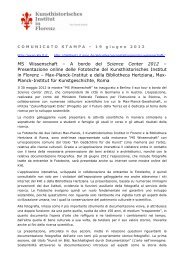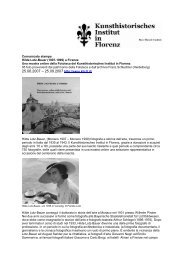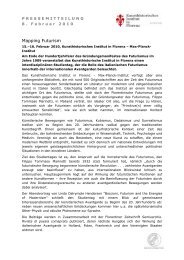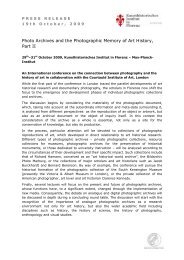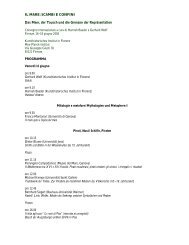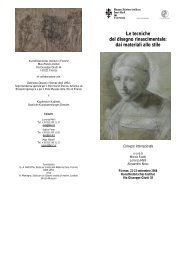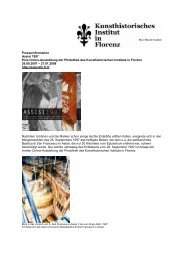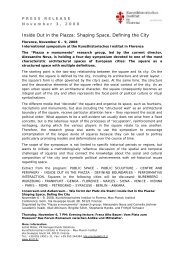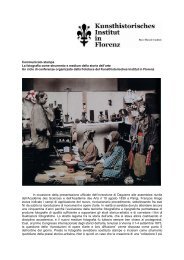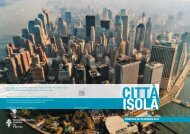Architectura Picta - Kunsthistorisches Institut in Florenz
Architectura Picta - Kunsthistorisches Institut in Florenz
Architectura Picta - Kunsthistorisches Institut in Florenz
Create successful ePaper yourself
Turn your PDF publications into a flip-book with our unique Google optimized e-Paper software.
ÉCOLE PRATIQUE DES HAUTES ÉTUDES, PARIS<br />
KUNSTHISTORISCHES INSTITUT IN FLORENZ, MAX-PLANCK-INSTITUT<br />
CALL FOR PAPER<br />
International Conference<br />
<strong>Architectura</strong> <strong>Picta</strong><br />
The Representation of Architecture <strong>in</strong> Pa<strong>in</strong>t<strong>in</strong>g<br />
(1300 – 1600)<br />
Paris, 14 - 16 December 2009<br />
Organized by<br />
Sab<strong>in</strong>e Frommel and Gerhard Wolf<br />
This conference is dedicated to the representations of architecture <strong>in</strong> both pa<strong>in</strong>t<strong>in</strong>g and draw<strong>in</strong>g. It<br />
has been organized around an <strong>in</strong>terdiscipl<strong>in</strong>ary topic and developed <strong>in</strong> the context of European<br />
scholarship, embrac<strong>in</strong>g a wide spectrum of topics spann<strong>in</strong>g from the metaphorical significance of<br />
architectural monuments, encompass<strong>in</strong>g both ru<strong>in</strong>s and build<strong>in</strong>gs <strong>in</strong> progress to the actual<br />
pictorial modes with which architectural spaces are evoked, bear<strong>in</strong>g <strong>in</strong> m<strong>in</strong>d processes such as<br />
fragmentation, transmutation and codification, as well as stylistic elements like the emulation of<br />
plasticity and chiaroscuro. Central themes <strong>in</strong> this discussion will be the migration of artistic<br />
formulas and ideas, how these ideas circulated, and the artistic dialogue between “North and<br />
South.”<br />
S<strong>in</strong>ce antiquity the art of build<strong>in</strong>g has been tightly l<strong>in</strong>ked to other arts – pa<strong>in</strong>t<strong>in</strong>g, draw<strong>in</strong>g, relief<br />
sculpture, literature and music – which afforded artists a broad spectrum of complimentary and<br />
<strong>in</strong>terrelated experiences. At the same time, architectural projects offered to the other arts not only<br />
artistic models but also theoretical concepts and structures. In some cases it was precisely pa<strong>in</strong>ted<br />
architecture that anticipated the advent of new architectural formulae. Pa<strong>in</strong>ted architecture can<br />
also underl<strong>in</strong>e recent artistic and technical developments, or provide a variety of solutions to
theoretical problems, such as historical reconstructions or elaborate architecture that is genu<strong>in</strong>ely<br />
produced by artistic phantasy, freed from any real technical constra<strong>in</strong>ts. The way <strong>in</strong> which pa<strong>in</strong>ters<br />
represent build<strong>in</strong>gs, <strong>in</strong>teriors or urban spaces unveils not only the artist’s personal perceptions and<br />
<strong>in</strong>terpretations of the physical environment but also that of his cultural milieu.<br />
Adopt<strong>in</strong>g an approach that is both synchronic and diachronic, this conference seeks to analyze fluid<br />
exchanges between the history of architecture and the visual arts between 1300 and 1600. Giotto<br />
was the pioneer <strong>in</strong> reviv<strong>in</strong>g certa<strong>in</strong> antique models <strong>in</strong> his pa<strong>in</strong>t<strong>in</strong>gs, prefigur<strong>in</strong>g the artistic<br />
approach of the Renaissance. With his treatises On Pa<strong>in</strong>t<strong>in</strong>g and On the Art of Build<strong>in</strong>g, Leon<br />
Battista Alberti offered new po<strong>in</strong>ts of reference and stimulated a variety of experiences, for example<br />
with his provocative suggestion that architectural elements are the <strong>in</strong>vention of pa<strong>in</strong>ters, or his<br />
dist<strong>in</strong>ction between architectural draw<strong>in</strong>g and draw<strong>in</strong>gs for the visual arts. Generally, the pr<strong>in</strong>cipal<br />
experimenters of the fifteenth century – Alberti, Donatello, Mantenga, Piero della Francesca,<br />
Perug<strong>in</strong>o, Botticelli, P<strong>in</strong>turicchio, Francesco di Giorgio – sought to f<strong>in</strong>d new solutions us<strong>in</strong>g<br />
pa<strong>in</strong>ted architecture to assimilate ancient paradigms <strong>in</strong>to modern aesthetic pr<strong>in</strong>ciples. The<br />
<strong>in</strong>vention of pictorial perspective made particular use of “architectura picta”, creat<strong>in</strong>g space for the<br />
pa<strong>in</strong>ted Historia, which on the one hand relies on the study of architecture and on the other hand<br />
consists <strong>in</strong> the elaboration of the rhetorical and narrative function of architectural “bodies” with<strong>in</strong><br />
the pictorial field. <strong>Architectura</strong>l elements such as cornices establish the boundary between the<br />
pa<strong>in</strong>ted world and the realm of viewer, effectively render<strong>in</strong>g the pa<strong>in</strong>ted field a w<strong>in</strong>dow, a<br />
proscenium or a tapestry. Moreover, the relationship between the human figure and architecture<br />
became a fundamental topos of Renaissance art.<br />
Rome <strong>in</strong> the early sixteenth century was a veritable laboratory of pa<strong>in</strong>ted architecture, and from its<br />
examples were derived the models that became touchstones for later generations. Raphael and his<br />
followers enriched and multiplied classical architectural prototypes by <strong>in</strong>terpret<strong>in</strong>g and draw<strong>in</strong>g<br />
them with <strong>in</strong>creas<strong>in</strong>g philological rigor. Beg<strong>in</strong>n<strong>in</strong>g <strong>in</strong> the 1530s there was a codification of<br />
architectural language due to the circulation of engrav<strong>in</strong>gs as well as architectural treatises. Of<br />
primary importance here was Sebastiano Serlio’s treatise, the Quarto e Terzo libro (1537 and 1540,<br />
respectively), which were a touchstone not only <strong>in</strong> the parts of Italy that had not yet experienced<br />
the revival of classical architecture, but also <strong>in</strong> other European countries. At the same time, there<br />
were also a number of artists - here one need only th<strong>in</strong>k of Pirro Ligorio, Titian or T<strong>in</strong>toretto - who<br />
cont<strong>in</strong>ued expand<strong>in</strong>g the repertoire of pa<strong>in</strong>ted architecture, cont<strong>in</strong>ued to re<strong>in</strong>vent models and<br />
elaborate new modes of representation.<br />
In the context of a debate that seeks to consider both micro-history as well as changes over the<br />
longue durée, encourag<strong>in</strong>g multiple viewpo<strong>in</strong>ts ought to promote a broaden<strong>in</strong>g of discipl<strong>in</strong>ary<br />
boundaries. Similarly, the conference seeks to <strong>in</strong>cite revisions of the periodization of the history of<br />
art and the creative dynamics between artistic genres as well as to develop a more accurate and<br />
nuanced understand<strong>in</strong>g of the mutations and <strong>in</strong>terrelations of artistic languages.<br />
Abstracts (250 words, at least) and a short Curriculum Vitae (1 page, at least) should be send by<br />
15 th June 2009 to the Scientific Secretary<br />
Scientific Secretary:<br />
Flam<strong>in</strong>ia Bardati (flam<strong>in</strong>ia.bardatimail.com)<br />
Susanne Pollack (pollack@khi.fi.it)
ÉCOLE PRATIQUE DES HAUTES ÉTUDES, PARIS<br />
KUNSTHISTORISCHES INSTITUT IN FLORENZ, MAX-PLANCK-INSTITUT<br />
APPEL À CONTRIBUTION<br />
Colloque <strong>in</strong>ternational<br />
<strong>Architectura</strong> picta<br />
la représentation de l'architecture dans la pe<strong>in</strong>ture<br />
(1300-1600)<br />
Paris, 14 - 16 décembre 2009<br />
sous la direction scientifique de<br />
Sab<strong>in</strong>e Frommel et Gerhard Wolf<br />
Organisée autour de problématiques <strong>in</strong>terdiscipl<strong>in</strong>aires qui se sont développées dans un contexte<br />
d'études européennes, cette rencontre est consacrée aux représentations de l'architecture dans la<br />
pe<strong>in</strong>ture et le dess<strong>in</strong>. La réflexion s'étend sur un ample spectre qui va de la dimension<br />
métaphorique des monuments, ru<strong>in</strong>es et chantiers jusqu'aux manières et aux styles picturaux avec<br />
lesquels l'architecture et l'espace sont évoqués. Elle prend également en considération les<br />
processus de fragmentation, transmutation et codification a<strong>in</strong>si que les effets plastiques et de clairobscur.<br />
La migration des formules et des concepts, le dialogue "nord-sud" et les voies de diffusion<br />
joueront un rôle central dans ce débat.<br />
Dès l'Antiquité, l'art de bâtir a été étroitement lié aux autres genres artistiques –la pe<strong>in</strong>ture, le<br />
dess<strong>in</strong>, le bas-relief, la littérature, la musique– qui ont offert aux maîtres un riche éventail<br />
d'expériences transversales et complémentaires. Mais, en même temps, les édifices et les projets<br />
d'architecture ont mis à disposition des autres arts des modèles, des concepts théoriques et des<br />
structures. Parfois, l'architectura picta a même anticipé l'<strong>in</strong>stauration de nouvelles formules. Elle a
la capacité d'exalter les acquisitions les plus récentes, qu'elles soient techniques ou artistiques, de<br />
proposer plusieurs <strong>in</strong>terprétations des données théoriques, en tant que reconstruction historique,<br />
ou encore d'élaborer de véritables fantaisies architecturales, <strong>in</strong>dépendantes de toutes<br />
considérations techniques. La manière choisie par les pe<strong>in</strong>tres pour représenter des édifices, des<br />
<strong>in</strong>térieurs ou des espaces urba<strong>in</strong>s révèle également leur perception et leur <strong>in</strong>terprétation de<br />
l'entourage physique a<strong>in</strong>si que celles de la société à laquelle ils appartiennent.<br />
Dans ce cadre, le colloque, adoptant un approche à la fois synchronique et diachronique, se<br />
propose d'analyser les rapports osmotiques entre l'histoire de l'architecture et les arts figuratifs<br />
entre 1300 et 1600. Giotto a été le pionnier et, dans certa<strong>in</strong>es représentations, il ressuscite des<br />
modèles anciens, en préfigurant la vision artistique de la Renaissance. Grâce aux traités De Pictura<br />
et De Re Aedificatoria, Léon Battista Alberti a offert de nouveaux po<strong>in</strong>ts de repère, en stimulant<br />
des expériences hétérogènes, par sa thèse provocatrice selon laquelle les éléments architecturaux<br />
seraient l'<strong>in</strong>vention des pe<strong>in</strong>tres, ou par la dist<strong>in</strong>ction qu'il fait entre dess<strong>in</strong> d'architecture et dess<strong>in</strong><br />
pictural. En général, les protagonistes du XVe siècle qui ont expérimenté des solutions/<strong>in</strong>ventions<br />
nouvelles par le biais de l'architecture pe<strong>in</strong>te –Alberti, Donatello, Mantegna, Piero della Francesca,<br />
Perug<strong>in</strong>o, Botticelli, P<strong>in</strong>turicchio, Francesco di Giorgio– ont assimilé les paradigmes de l'Antiquité<br />
aux pr<strong>in</strong>cipes esthétiques modernes. L'<strong>in</strong>vention de la perspective utilise particulièrement<br />
l'architectura picta af<strong>in</strong> de créer un espace pour l’historia qui se nourrit de l'étude de<br />
l'architecture d'une part, et de l'autre, consiste en l'élaboration de la fonction rhétorique ou<br />
narrative des objets d'architecture dans l'espace pictural (avec ses cadres qui se présentent en tant<br />
qu'<strong>in</strong>terface par rapport aux réalités extérieures, rendant des images telles qu’une fenêtre, une<br />
scène ou une tapisserie). Le rapport entre corps huma<strong>in</strong> et architecture devient lui aussi un topos<br />
de la Renaissance.<br />
À Rome, le début du C<strong>in</strong>quecento constitue un véritable « laboratoire » pour l'architecture pe<strong>in</strong>te<br />
dont ont dérivé les modèles qui ont été aff<strong>in</strong>és et exportés par la suite. Raphaël et ses disciples ont<br />
enrichi et multiplié les prototypes de l'architecture classique, dess<strong>in</strong>és et <strong>in</strong>terprétés avec une<br />
rigueur philologique croissante. À partir des années 1530, la codification du langage architectural<br />
se met en place grâce à la diffusion des gravures et des traités. Sebastiano Serlio figure parmi les<br />
premiers <strong>in</strong>termédiaires; ses Livres IV et III (1537 et 1540) exercent une <strong>in</strong>fluence fondamentale,<br />
non seulement dans les régions italiennes qui n'ont pas encore été touchées par le souffle classique,<br />
mais également dans les autres pays européens. En même temps, d'autres artistes, tels Pirro<br />
Ligorio, Titien ou T<strong>in</strong>toretto, cont<strong>in</strong>uent à élargir le répertoire, à ré<strong>in</strong>venter des modèles et à mettre<br />
au po<strong>in</strong>t de nouvelles manières de représentation.<br />
La multiplication des po<strong>in</strong>ts de vue, au se<strong>in</strong> d'un débat qui veut prendre en charge à la fois la<br />
micro-histoire et les mutations à long terme, doit conduire à l'élargissement des limites<br />
discipl<strong>in</strong>aires, par un regard croisé, visant à la révision de la périodisation de l'histoire de l'art, à la<br />
déterm<strong>in</strong>ation des dynamiques créatives entre genres artistiques et à une vision, en même temps<br />
plus aigue et plus nuancée, des mutations et des <strong>in</strong>terrelations des langages des arts.<br />
Les propositions de communications (1500 s. max.), accompagnées d’un bref curriculum vitae (1<br />
page max.), devront être envoyées via émail avant le 15 ju<strong>in</strong> 2009 au Secrétariat scientifique du<br />
colloque.<br />
Secrétariat scientifique<br />
Flam<strong>in</strong>ia Bardati (flam<strong>in</strong>ia.bardati@gmail.com)<br />
Susanne Pollack (pollack@khi.fi.it)
ÉCOLE PRATIQUE DES HAUTES ÉTUDES, PARIS<br />
KUNSTHISTORISCHES INSTITUT IN FLORENZ, MAX-PLANCK-INSTITUT<br />
CALL FOR PAPER<br />
Convegno <strong>in</strong>ternazionale di studi<br />
<strong>Architectura</strong> <strong>Picta</strong><br />
La rappresentazione dell'architettura nella pittura<br />
(1300 – 1600)<br />
Parigi, 14 - 16 dicembre 2009<br />
a cura di<br />
Sab<strong>in</strong>e Frommel e Gerhard Wolf<br />
Articolato <strong>in</strong>torno a problematiche <strong>in</strong>terdiscipl<strong>in</strong>ari sviluppate <strong>in</strong> un contesto di studi europei,<br />
questo <strong>in</strong>contro è dedicato alle raffigurazioni architettoniche nella pittura e nel disegno. La<br />
riflessione abbraccia un ampio spectrum che va dalla dimensione metaforica di monumenti, ruderi<br />
e cantieri f<strong>in</strong>o ai modi e agli stili pittorici stessi <strong>in</strong> cui l’architettura e lo spazio vennero evocati,<br />
tenendo conto dei processi di frammentazione, trasmutazione o codificazione f<strong>in</strong>o agli effetti<br />
plastici e chiaroscurali. La migrazione di formule e concetti, il dialogo “nord-sud” e le vie di<br />
circolazione giocheranno un ruolo centrale <strong>in</strong> questo dibattito.<br />
F<strong>in</strong> dall'antichità l'arte di costruire è stata strettamente legata agli altri generi artistici –la pittura, il<br />
disegno, il basso-rilievo, la letteratura, la musica– che hanno offerto ai maestri un ricco ventaglio di<br />
esperienze trasversali e complementari. Ma, al contempo, edifici e progetti architettonici hanno<br />
messo a disposizione degli altri generi artistici modelli, concetti teorici e strutture. In alcuni casi è<br />
stata proprio l'architectura picta ad anticipare l'istaurarsi di nuove formule.<br />
Ma essa ha anche la capacità di esaltare le acquisizioni più recenti, al livello sia artistico che<br />
tecnico, o di proporre diverse <strong>in</strong>terpretazioni delle istanze teoriche, <strong>in</strong> veste di ricostruzioni<br />
storiche, oppure di elaborare vere e proprie fantasie architettoniche, libere da ogni considerazione<br />
tecnica. Il modo <strong>in</strong> cui i pittori rappresentano edifici, <strong>in</strong>terni o spazi urbani svela la percezione e
l'<strong>in</strong>terpretazione dell’entourage fisico da parte dell’artista e anche della società alla quale egli<br />
appartiene.<br />
Adottando <strong>in</strong> questa cornice un approccio sia s<strong>in</strong>cronico che diacronico, il convegno vuole<br />
analizzare i rapporti osmotici tra la storia dell'architettura e delle arti figurative tra il 1300 e il<br />
1600. Giotto è stato il pioniere e <strong>in</strong> alcune rappresentazioni resuscita modelli antichi, prefigurando<br />
l’approccio artistico del R<strong>in</strong>ascimento. Con i trattati De Pictura e De Re Aedificatoria, Leon<br />
Battista Alberti ha offerto nuovi riferimenti, stimolando esperienze eterogenee, per esempio con la<br />
sua provocatoria tesi che gli elementi architettonici siano <strong>in</strong>venzioni dei pittori o con la sua<br />
dist<strong>in</strong>zione tra il disegno architettonico e quello pittorico. In l<strong>in</strong>ea di massima i protagonisti del XV<br />
secolo che sperimentano nuove soluzioni/<strong>in</strong>venzioni tramite l’architettura dip<strong>in</strong>ta –Alberti,<br />
Donatello, Mantenga, Piero della Francesca, Perug<strong>in</strong>o, Botticelli, P<strong>in</strong>turicchio, Francesco di<br />
Giorgio– assimilano i paradigmi dell’antico ai pr<strong>in</strong>cipi estetici moderni. L’<strong>in</strong>venzione della<br />
prospettiva si serve particolarmente dell’architettura picta, creando uno spazio per la “historia”,<br />
che da un lato si nutre dello studio dell’architettura e dall’altro consiste nell’elaborazione della<br />
funzione retorica o narrativa dei corpi architettonici nel campo pittorico (con le sue cornici, che si<br />
presentano come un’<strong>in</strong>terfaccia con le realtà esterne, rendendo l’immag<strong>in</strong>e di una f<strong>in</strong>estra, un<br />
palcoscenico o un arazzo). Inoltre il rapporto tra corpo umano e architettura, diventa un topos<br />
fondamentale del R<strong>in</strong>ascimento.<br />
A Roma il primo C<strong>in</strong>quecento costituisce un vero « laboratorio » per l'architettura dip<strong>in</strong>ta, da cui<br />
sono derivati i modelli che divennero oggetto di aff<strong>in</strong>amenti e di esportazione. Raffaello e i suoi<br />
seguaci arricchiscono e moltiplicano i prototipi architettonici classici, disegnati e <strong>in</strong>terpretati con<br />
crescente rigore filologico. A partire degli anni Trenta, grazie alla circolazione delle <strong>in</strong>cisioni e dei<br />
trattati d'architettura, prende atto una codificazione del l<strong>in</strong>guaggio architettonico. Tra i primi<br />
mediatori è il trattato di Sebastiano Serlio; il Quarto e Terzo libro (1537 e 1540) esercitano un<br />
<strong>in</strong>flusso fondamentale, non solo nelle regioni italiane ancora non raggiunte dal respiro classico, ma<br />
anche <strong>in</strong> altri paesi europei. Allo stesso tempo non mancano artisti, basti pensare a Pirro Ligorio,<br />
Tiziano o T<strong>in</strong>toretto, che cont<strong>in</strong>uano ad allargare il repertorio, a re-<strong>in</strong>ventare modelli e a mettere a<br />
punto nuovi modi di rappresentazione.<br />
La moltiplicazione dei punti di vista, <strong>in</strong> seno a un dibattito che vuole prendere <strong>in</strong> considerazione sia<br />
la micro-storia che le mutazioni a lungo term<strong>in</strong>e, deve sfociare <strong>in</strong> un allargamento dei limiti<br />
discipl<strong>in</strong>ari, <strong>in</strong> uno sguardo <strong>in</strong>crociato, mirando a una revisione della periodizzazione della storia<br />
dell’arte e all’<strong>in</strong>dividuazione di d<strong>in</strong>amiche creative tra i generi artistici e a una visione, più acuta e<br />
sfumata, delle mutazioni e <strong>in</strong>terrelazioni dei l<strong>in</strong>guaggi delle arti.<br />
Le proposte di comunicazione (1500 caratteri al massimo), accompagnate da un breve curriculum<br />
vitae (1 pag<strong>in</strong>a al massimo), dovranno essere <strong>in</strong>viate via email entro il 15 giugno 2009 alla<br />
segreteria scientifica del convegno.<br />
Segreteria scientifica e organizzativa:<br />
Flam<strong>in</strong>ia Bardati (flam<strong>in</strong>ia.bardati@gmail.com)<br />
Susanne Pollack (pollack@khi.fi.it)



